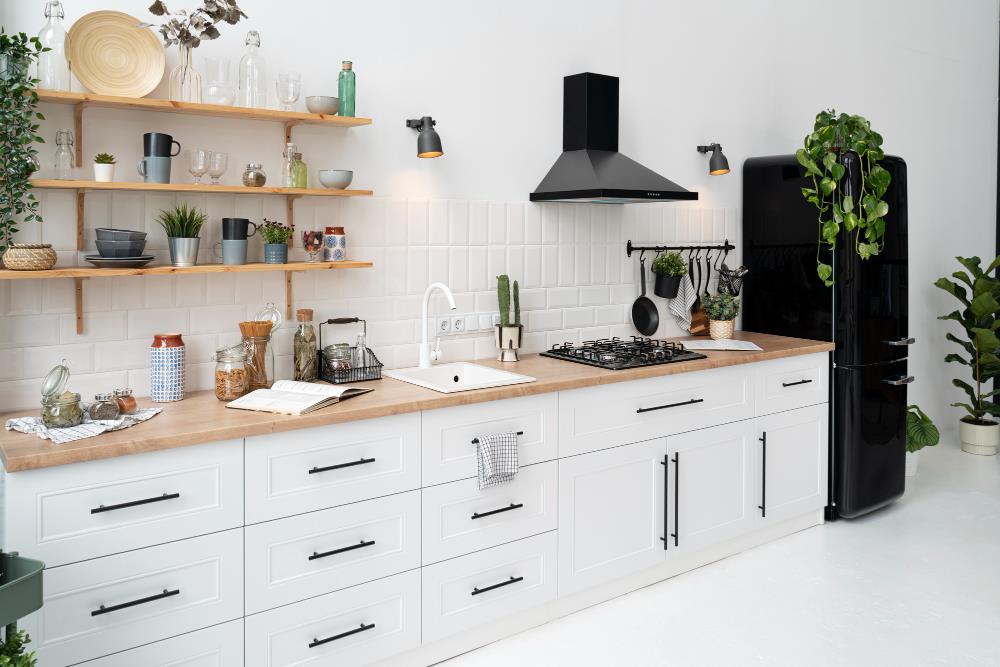Wood vs. Laminate vs. Metal: Comparing Kitchen Cabinet Materials

Discover the different materials for kitchen cabinets - wood, laminate, and metal. Learn about their characteristics, pros, and cons to make an informed decision for your kitchen design.
Kitchen cabinets are storage units typically installed in kitchens to provide organized storage space for various kitchen essentials such as cookware, utensils, dishes, and food items. They are typically placed along the walls of the kitchen, above countertops, and sometimes below the countertop as well. Kitchen cabinets come in various sizes, styles, and materials, allowing homeowners to choose options that match their kitchen design and meet their storage needs. They often consist of shelves, drawers, and doors that can be opened and closed to access the stored items. Kitchen cabinets not only provide functional storage but also contribute to the overall aesthetics and design of the kitchen. The choice of kitchen cabinet materials plays a vital role in both the aesthetic appeal and practicality of a kitchen. Three primary materials often considered are wood, laminate, and metal. Wood exudes a timeless and natural charm, offering durability and a variety of finishes, but it can be susceptible to moisture damage. Laminate, on the other hand, provides a budget-friendly option with extensive design choices, but it may lack the durability of other materials. Metal cabinets deliver a sleek and contemporary look, coupled with excellent durability and resistance to moisture, but they may be prone to scratches. Understanding the characteristics, pros, and cons of each material helps homeowners make informed decisions to achieve their desired kitchen design and functionality. Lets take a look at the different kitchen cabinet materials & their pros and cons, explained to us by one of the best interior designers in Kochi, Kerala. Wood cabinets have long been popular in kitchens due to their timeless appeal and natural beauty. Various types of wood, such as oak, maple, and cherry, are commonly used for kitchen cabinets, each offering unique characteristics and aesthetics. Wood cabinets are known for their durability, able to withstand the demands of daily use. Additionally, they offer a wide range of customization options, including different stains and finishes. However, wood cabinets tend to be more expensive than other materials, and they require regular maintenance to keep them looking their best. Moisture can also be a concern, as excessive exposure may lead to warping or damage. Nonetheless, the enduring charm and versatility of wood cabinets make them a popular choice for many homeowners. Laminate cabinets serve as a cost-effective alternative to wood cabinets. Composed of layers of synthetic materials, laminate cabinets are manufactured by applying a printed and textured surface to a sturdy core. They offer several advantages, including affordability, making them a popular choice for budget-conscious homeowners. Laminate cabinets are also highly durable and resistant to scratches, stains, and moisture. Moreover, they provide a vast array of design options, allowing for customization and replication of various materials like wood or stone. However, laminate cabinets may lack the perceived value of natural materials like wood and can be challenging to repair if damaged. Despite these limitations, laminate cabinets offer a practical and stylish solution for those seeking an affordable and low-maintenance option for their kitchen. Metal cabinets have gained popularity in modern kitchen designs due to their sleek aesthetics and contemporary appeal. Stainless steel and aluminum are commonly used metals for cabinets. Metal cabinets offer numerous advantages, including exceptional durability and resistance to moisture, making them ideal for high-traffic kitchens. They are also easy to clean and maintain, requiring minimal effort to keep them looking their best. However, metal cabinets can be more expensive than other materials, and they may be susceptible to scratches and dents. Additionally, the design options for metal cabinets can be limited compared to wood or laminate. Despite these drawbacks, metal cabinets bring a modern and industrial flair to kitchens and are favored for their durability and low maintenance requirements. When choosing between wood, laminate, and metal cabinets, several factors should be considered. Budget plays a significant role, as wood cabinets tend to be more expensive, while laminate offers a more affordable option. Style preferences should also be considered, as wood cabinets exude a timeless charm, laminate provides diverse design options, and metal cabinets offer a modern, sleek look. Durability requirements vary, with wood and metal cabinets being more durable than laminate. Lifestyle factors such as moisture resistance and scratch resistance should be evaluated based on the kitchen's usage and the homeowner's needs. It's essential to prioritize these factors based on individual preferences and requirements. Real-life examples and case studies can help illustrate how different materials enhance various kitchen styles and design concepts, aiding in the decision-making process. Comparison of Wood, Laminate, and Metal Cabinets: When considering kitchen cabinets, it's important to compare the key characteristics of wood, laminate, and metal cabinets. Here's a breakdown of their features: 1. Natural Beauty: 2. Durability: 3. Customization: 4. Affordability: 5. Moisture Resistance: 6. Scratch Resistance: 7. Repairability: 8. Aesthetics: Wood cabinets tend to be more expensive than laminate cabinets due to the cost of the materials and the craftsmanship involved in their production. Yes, laminate cabinets are known for their high moisture resistance, making them suitable for kitchens where exposure to moisture is common. While metal cabinets are generally durable, they can be susceptible to scratches. However, stainless steel cabinets are often designed with a brushed finish that helps to minimize the appearance of scratches. Repairing damaged laminate cabinets can be challenging as the laminate surface cannot be easily repaired. In many cases, the entire cabinet door or panel may need to be replaced to fix significant damage. Yes, metal cabinets are often favored in modern kitchen designs due to their sleek aesthetics and contemporary appeal. They can create a clean and minimalist look that complements a modern or industrial-style kitchen. Yes, wood cabinets require regular maintenance to keep them looking their best. This includes periodic cleaning, polishing, and potentially refinishing or resealing depending on the type of wood and finish. Proper care helps protect the wood from moisture damage and extends the lifespan of the cabinets. Yes, wood cabinets offer a high level of customization. They can be stained or painted in various colors and finishes, allowing homeowners to achieve a wide range of styles, from traditional to contemporary.What are Kitchen Cabinets?
Kitchen Cabinet Materials: Wood vs Laminate vs Metal
Wood Cabinets
Laminate Cabinets
Metal Cabinets
Comparison between Wood vs Laminate vs Metal cabinets
- Wood Cabinets: Yes
- Laminate Cabinets: Yes
- Metal Cabinets: No
- Wood Cabinets: Yes
- Laminate Cabinets: Moderate
- Metal Cabinets: Yes
- Wood Cabinets: High
- Laminate Cabinets: High
- Metal Cabinets: Moderate
- Wood Cabinets: Moderate
- Laminate Cabinets: Yes
- Metal Cabinets: Moderate
- Wood Cabinets: Moderate
- Laminate Cabinets: High
- Metal Cabinets: High
- Wood Cabinets: Moderate
- Laminate Cabinets: Moderate
- Metal Cabinets: High
- Wood Cabinets: Yes
- Laminate Cabinets: Limited
- Metal Cabinets: Limited
- Wood Cabinets: Timeless
- Laminate Cabinets: Varied
- Metal Cabinets: ModernFAQs
